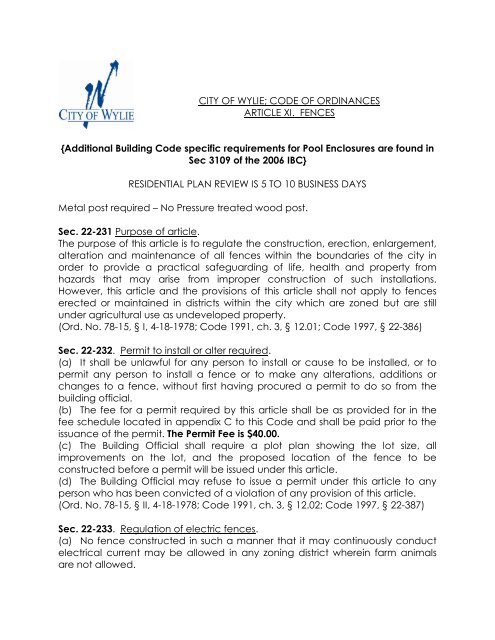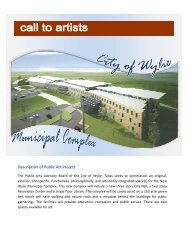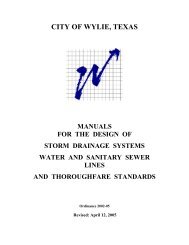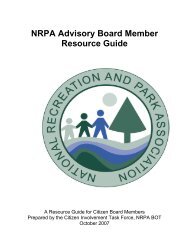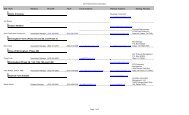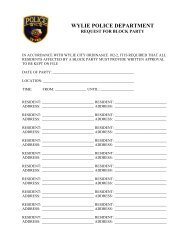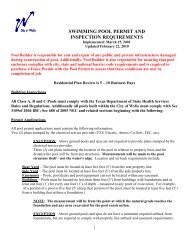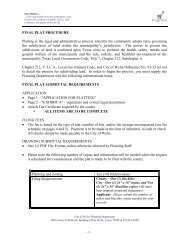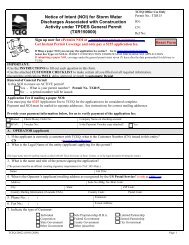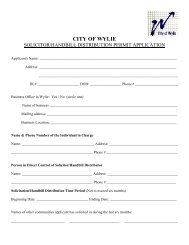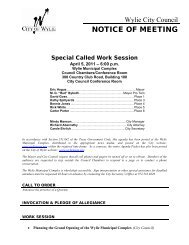CITY OF WYLIE; CODE OF ORDINANCES ARTICLE XI. FENCES ...
CITY OF WYLIE; CODE OF ORDINANCES ARTICLE XI. FENCES ...
CITY OF WYLIE; CODE OF ORDINANCES ARTICLE XI. FENCES ...
Create successful ePaper yourself
Turn your PDF publications into a flip-book with our unique Google optimized e-Paper software.
<strong>CITY</strong> <strong>OF</strong> <strong>WYLIE</strong>; <strong>CODE</strong> <strong>OF</strong> <strong>ORDINANCES</strong><br />
<strong>ARTICLE</strong> <strong>XI</strong>. <strong>FENCES</strong><br />
{Additional Building Code specific requirements for Pool Enclosures are found in<br />
Sec 3109 of the 2006 IBC}<br />
RESIDENTIAL PLAN REVIEW IS 5 TO 10 BUSINESS DAYS<br />
Metal post required – No Pressure treated wood post.<br />
Sec. 22-231 Purpose of article.<br />
The purpose of this article is to regulate the construction, erection, enlargement,<br />
alteration and maintenance of all fences within the boundaries of the city in<br />
order to provide a practical safeguarding of life, health and property from<br />
hazards that may arise from improper construction of such installations.<br />
However, this article and the provisions of this article shall not apply to fences<br />
erected or maintained in districts within the city which are zoned but are still<br />
under agricultural use as undeveloped property.<br />
(Ord. No. 78-15, § I, 4-18-1978; Code 1991, ch. 3, § 12.01; Code 1997, § 22-386)<br />
Sec. 22-232. Permit to install or alter required.<br />
(a) It shall be unlawful for any person to install or cause to be installed, or to<br />
permit any person to install a fence or to make any alterations, additions or<br />
changes to a fence, without first having procured a permit to do so from the<br />
building official.<br />
(b) The fee for a permit required by this article shall be as provided for in the<br />
fee schedule located in appendix C to this Code and shall be paid prior to the<br />
issuance of the permit. The Permit Fee is $40.00.<br />
(c) The Building Official shall require a plot plan showing the lot size, all<br />
improvements on the lot, and the proposed location of the fence to be<br />
constructed before a permit will be issued under this article.<br />
(d) The Building Official may refuse to issue a permit under this article to any<br />
person who has been convicted of a violation of any provision of this article.<br />
(Ord. No. 78-15, § II, 4-18-1978; Code 1991, ch. 3, § 12.02; Code 1997, § 22-387)<br />
Sec. 22-233. Regulation of electric fences.<br />
(a) No fence constructed in such a manner that it may continuously conduct<br />
electrical current may be allowed in any zoning district wherein farm animals<br />
are not allowed.
(b) Single-strand wires designed to conduct electricity through an approved<br />
low-voltage regulator shall be allowed only along the interior base line of an<br />
otherwise permitted fence. No permit shall be required for the erection and<br />
maintenance of such single-strand electric wires.<br />
(Ord. No. 78-15, § III, 4-18-1978; Code 1991, ch. 3, § 12.03; Code 1997, § 22-388)<br />
Sec. 22-234. Compliance with the zoning ordinance.<br />
All fences and fence locations shall conform to the requirements of the zoning<br />
ordinance of the city, and nothing in this article shall be construed as permitting<br />
construction of a fence which would violate the provisions of the zoning<br />
ordinance, as such ordinance presently exists or as it may be hereafter<br />
amended. Fences must be constructed using metal posts. Pressure treated<br />
wood is prohibited. All wood fences must have rails facing inside. Maximumn<br />
fence height is 8’ from grade.<br />
(Code 1991, ch. 3, § 12.04; Code 1997, § 22-389)<br />
Sec. 22-235. Location on or protrusion over city property.<br />
No privately owned fence or guy wires, braces or any other part of a privately<br />
owned fence shall be constructed upon or caused to protrude over property<br />
owned by the city.<br />
(Code 1991, ch. 3, § 12.05; Code 1997, § 22-390)<br />
Sec. 22-236. Visibility obstruction.<br />
No fence shall be erected or maintained in a manner so as to be a visibility<br />
obstruction as indicated in figure 1 of this section and made a part of this<br />
section.<br />
GRAPHIC attached last page.<br />
(Ord. No. 78-15, § VI, 4-18-1978; Code 1991, ch. 3, § 12.06; Code 1997, § 22-391)<br />
Sec. 22-237. Height limit along rear yard or alley line in residential districts.<br />
No fence shall be constructed at a height exceeding eight feet along the rear<br />
yard or alley line in residential districts.<br />
{If built over/on retaining wall, height will be measured from inside grade}<br />
(Ord. No. 78-15, § VII, 4-18-1978; Code 1991, ch. 3, § 12.07; Code 1997, § 22-392)<br />
Sec. 22-238. Height limit on side yard line in residential districts.<br />
No fence shall be constructed at a height exceeding eight feet on any side<br />
yard line in residential districts up to the building line of the house proper. All<br />
such fences constructed on side yard lines in residential districts must be vertical.<br />
{If built over/on retaining wall, height will be measured from inside grade}<br />
(Ord. No. 78-15, § VIII, 4-18-1978; Code 1991, ch. 3, § 12.08; Code 1997, § 22-393)<br />
Sec. 22-239. Front yard fences in residential districts prohibited; exceptions.
No fence shall be constructed between the building line and front property line<br />
and/or street side building line for corner lots for residential buildings facing the<br />
side street, except for ornamental type fencing on side yard property lines built<br />
between the building line and front property line. Front yard ornamental type<br />
fences shall not exceed four feet in height with at least 50% through vision.<br />
(Ord. No. 78-15, § IX, 4-18-1978; Code 1991, ch. 3, § 12.09; Code 1997, § 22-394)<br />
Sec. 22-240. Height limit in industrial districts.<br />
No fence shall be constructed at a height exceeding ten feet in industrial<br />
districts.<br />
(Ord. No. 78-15, § X, 4-18-1978; Code 1991, ch. 3, § 12.10; Code 1997, § 22-395)<br />
Sec. 22-241. Height limit around tennis courts; fence arms.<br />
Fences around tennis courts, regardless of the district in which they are located,<br />
shall be constructed at a height not exceeding ten feet, and fence arms shall<br />
not be allowed thereon.<br />
(Code 1991, ch. 3, § 12.11; Code 1997, § 22-396)<br />
Sec. 22-242. Fence arms in residential district; limited in industrial districts.<br />
Fence arms shall not be permitted in residential districts or districts other than<br />
industrial. Fence arms may be permitted on fences located in industrial districts<br />
so long as they do not extend beyond the property line.<br />
(Ord. No. 78-15, § <strong>XI</strong>I, 4-18-1978; Code 1991, ch. 3, § 12.12; Code 1997, § 22-397)<br />
Sec. 22-243. Barbed wire.<br />
In no event shall barbed wire be permitted, except on arms in industrial zoning<br />
districts.<br />
(Code 1991, ch. 3, § 12.13; Code 1997, § 22-398)<br />
Sec. 22-244. Inspection of new fences.<br />
When any fence for which a permit has been issued under this article is<br />
completed, it must be inspected. The building official's office shall be notified<br />
upon completion of the fence. The building official will issue a card of<br />
acceptance if the fence complies with the provisions of this article, or reject the<br />
fence if it does not so comply.<br />
(Ord. No. 78-15, § <strong>XI</strong>V, 4-18-1978; Code 1991, ch. 3, § 12.14; Code 1997, § 22-399)<br />
Sec. 22-245. Maintenance.<br />
All fences constructed under the provisions of this article shall be maintained so<br />
as to comply with the requirements of this article at all times.<br />
(Ord. No. 78-15, § XV, 4-18-1978; Code 1991, ch. 3, § 12.15; Code 1997, § 22-400)<br />
Sec. 22-246. Appeals from decisions under this article.
Any appeal from an interpretation of the building official of the provisions of this<br />
article shall be made to the housing advisory and appeals board.<br />
(Ord. No. 78-15, § XVI, 4-18-1978; Code 1991, ch. 3, § 12.16; Code 1997, § 22-401)<br />
Sec. 22-247. Enclosures for swimming pools.<br />
{FENCE PERMITS ARE REQUIRED WITH EACH POOL PERMIT ISSUED}<br />
(a) Required. Every swimming pool, or excavation designed or intended to<br />
ultimately become a swimming pool, while under construction as well as after<br />
completion, shall be continuously protected by an enclosure surrounding the<br />
pool or excavated area in such a manner as to make such pool or excavated<br />
area reasonably inaccessible to small children or animals.<br />
(b) Exceptions to subsection (a) of this section. Exceptions to subsection (a) of<br />
this section are as follows:<br />
(1) Subsection (a) of this section shall not apply to bodies of water other than<br />
swimming pools which are owned or controlled by the federal, state or county<br />
government, or any agency, subdivision or department thereof; or bodies of<br />
water located in natural drainage ways.<br />
(2) In single-family occupancies, the enclosure may surround the entire singlefamily<br />
premises.<br />
(3) In multifamily occupancies, the enclosure may include the courtyard which<br />
surrounds the pool.<br />
(c) Enclosure specifications. An enclosure shall be a fence, wall or building not<br />
less than six feet in height with no openings, holes or gaps larger than four inches<br />
measured in any direction except that measurement for a picket fence (one<br />
composed primarily of vertical members) shall be measured in a horizontal<br />
direction between members.<br />
(d) Gates and doors. Gates and doors opening directly into such enclosure<br />
shall be equipped with self-closing and self-latching devices designed to keep,<br />
and capable of keeping, such doors or gates securely closed. The latching<br />
device shall be attached to the gate or door not less than 54 inches (per Sec<br />
3109, 2006 IBC) above the grade or the floor. The doors of any building forming<br />
any part of the enclosure required in this section need not be so equipped.<br />
(e) Maintenance of swimming pool without enclosure. It shall be unlawful to<br />
maintain any swimming pool in the corporate limits which is not protected by an<br />
enclosure in accordance with the requirements of this section.<br />
(f) Plans for swimming pools; requirements. All plans submitted to the city for<br />
swimming pools to be constructed shall show compliance with the requirements<br />
of this section, and the final inspection and approval of all pools constructed<br />
shall be withheld until all requirements of this section have been complied with<br />
by the owner, purchaser under contract, lessee, tenant or licensee.<br />
(Ord. No. 78-15, § XVII, 4-18-1978; Code 1991, ch. 3, § 12.17; Code 1997, § 22-<br />
402)
State law references: Municipal authority concerning swimming pool<br />
enclosures, V.T.C.A., Local Government Code § 214.101.<br />
Sec. 22-248. Fences in drainage easements.<br />
No fence shall be constructed within any drainage easement in the corporate<br />
limits of the city unless the city engineer shall have first determined and advised<br />
the building official, in writing, that he believes such fence shall, in all probability,<br />
not interfere with or impair the natural flow of water across the drainage<br />
easement.<br />
(Ord. No. 78-15, § XVIII, 4-18-1978; Code 1991, ch. 3, § 12.18; Code 1997, § 22-<br />
403)<br />
Secs. 22-249--22-260. Reserved.<br />
***Chain link fencing is allowed***<br />
City of Wylie Texas – 300 Country Club, Bldg 100, Wylie, Tx 75098 – www.wylietexas.gov 972-516-6420


